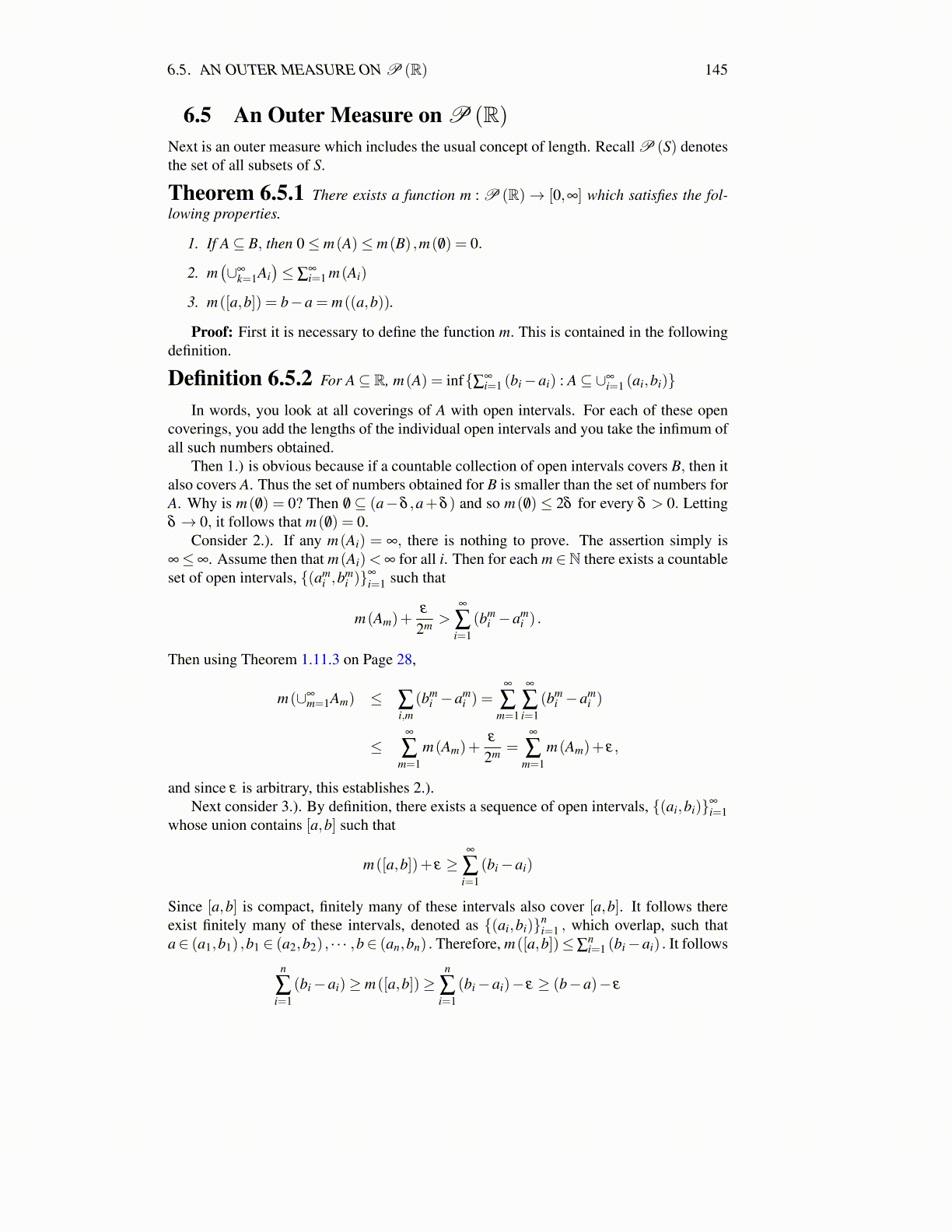
6.5. AN OUTER MEASURE ON P (R) 145
6.5 An Outer Measure on P (R)Next is an outer measure which includes the usual concept of length. Recall P (S) denotesthe set of all subsets of S.
Theorem 6.5.1 There exists a function m : P (R)→ [0,∞] which satisfies the fol-lowing properties.
1. If A⊆ B, then 0≤ m(A)≤ m(B) ,m( /0) = 0.
2. m(∪∞
k=1Ai)≤ ∑
∞i=1 m(Ai)
3. m([a,b]) = b−a = m((a,b)).
Proof: First it is necessary to define the function m. This is contained in the followingdefinition.
Definition 6.5.2 For A⊆ R, m(A) = inf{∑∞i=1 (bi−ai) : A⊆ ∪∞
i=1 (ai,bi)}
In words, you look at all coverings of A with open intervals. For each of these opencoverings, you add the lengths of the individual open intervals and you take the infimum ofall such numbers obtained.
Then 1.) is obvious because if a countable collection of open intervals covers B, then italso covers A. Thus the set of numbers obtained for B is smaller than the set of numbers forA. Why is m( /0) = 0? Then /0 ⊆ (a−δ ,a+δ ) and so m( /0) ≤ 2δ for every δ > 0. Lettingδ → 0, it follows that m( /0) = 0.
Consider 2.). If any m(Ai) = ∞, there is nothing to prove. The assertion simply is∞≤∞. Assume then that m(Ai)< ∞ for all i. Then for each m ∈N there exists a countableset of open intervals, {(am
i ,bmi )}
∞
i=1 such that
m(Am)+ε
2m >∞
∑i=1
(bmi −am
i ) .
Then using Theorem 1.11.3 on Page 28,
m(∪∞m=1Am) ≤ ∑
i,m(bm
i −ami ) =
∞
∑m=1
∞
∑i=1
(bmi −am
i )
≤∞
∑m=1
m(Am)+ε
2m =∞
∑m=1
m(Am)+ ε,
and since ε is arbitrary, this establishes 2.).Next consider 3.). By definition, there exists a sequence of open intervals, {(ai,bi)}∞
i=1whose union contains [a,b] such that
m([a,b])+ ε ≥∞
∑i=1
(bi−ai)
Since [a,b] is compact, finitely many of these intervals also cover [a,b]. It follows thereexist finitely many of these intervals, denoted as {(ai,bi)}n
i=1 , which overlap, such thata∈ (a1,b1) ,b1 ∈ (a2,b2) , · · · ,b∈ (an,bn) . Therefore, m([a,b])≤∑
ni=1 (bi−ai) . It follows
n
∑i=1
(bi−ai)≥ m([a,b])≥n
∑i=1
(bi−ai)− ε ≥ (b−a)− ε